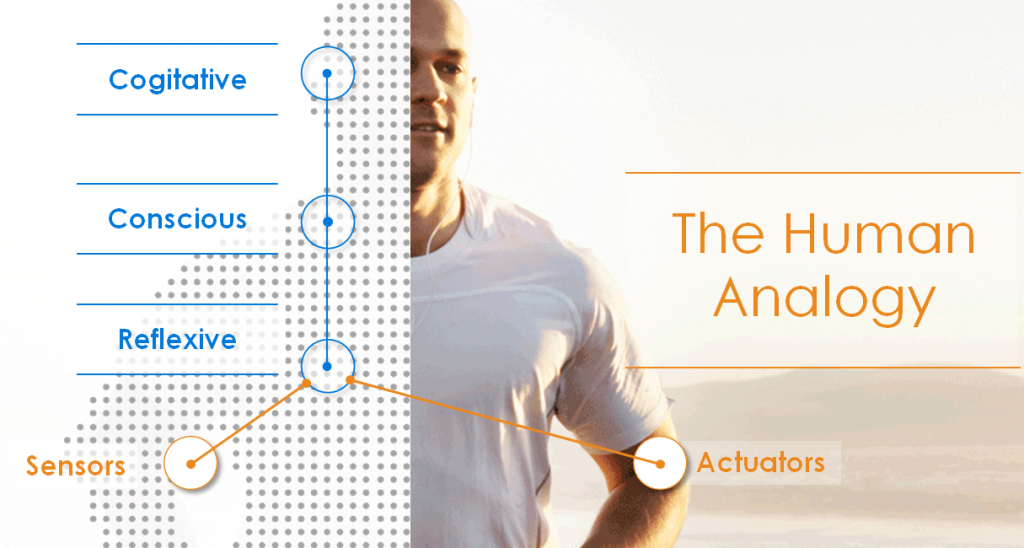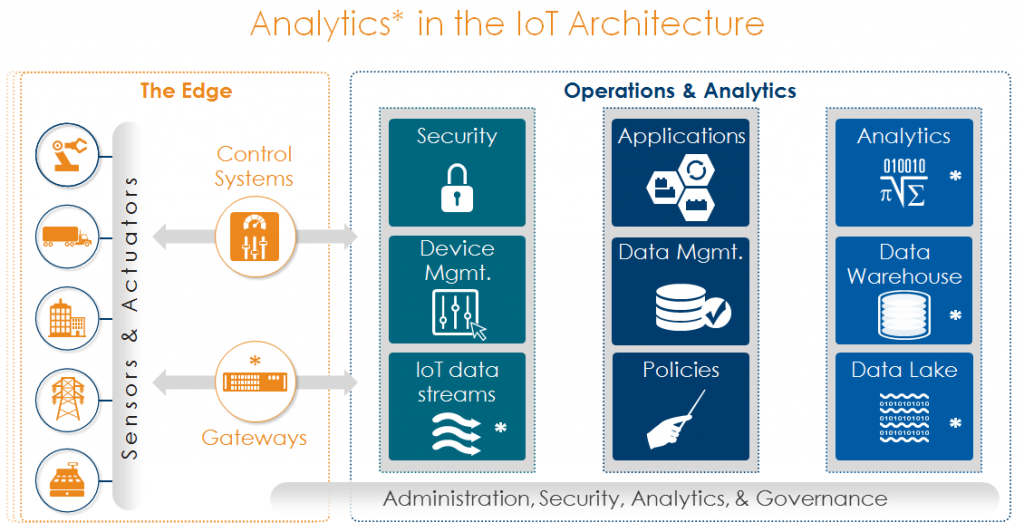Dan Graham, Director of Technical Marketing for IoT, Teradata
You can skip that New Year’s resolution to get a personal trainer. Your body is already sculpted to be the finest architecture ever designed. Thank your mom for the fact that the best engineers in the world constantly mimic the beauty that is you. Got your attention yet? How amazing are you? Let me explain.
Biomimicry means machines that imitate biological systems. So it should be no surprise that we copy the sensory gifts of the human body into our machine designs. Machines see, hear, smell, touch, and taste just as we do. Well, actually they do it much better. Observing the body’s senses, electric pulses, and responses, we find exquisite allegories for processing sensor data in the Internet of Things. What may be surprising is the way our bodies distribute intelligent processing. And the brain is not always engaged. (My wife yells that at me a lot.)
Livin’ on the Edge
Let’s start with a simple example. I walk over to the stove to pick up the tea kettle. Touch sensors in my fingers scream “the handle is hot.” Pain alerts my nervous system in milliseconds to “drop the kettle.” The actuators in my fingers obey. A second later, my conscious brain notices I forgot to use the pot holder. Seconds later, my brain cogitates: How can I prevent this in the future? Should I buy another kettle? The brain then saves a memory pattern to be wary in the future. Thus, we see the main principle of IoT biomimicry:
– Sensor data is processed locally (my hand)
– Sensor data is processed centrally (my noggin)
– Different levels of intelligence operate at different latencies
Our nervous system contains embedded rules and a powerful network for monitoring our senses. The hand can’t wait half a second for the brain to respond. The nervous system is pre-programmed with reactive responses to specific signals. But the nervous system has minimal memory and compute power. It operates now with a limited number of evolutionary rules to protect our body.
This is the same design in IoT edge architecture. There is always a control system or gateway server “out in the wild” where the things are. The gateway server has pre-programmed rules that react to sensor measurements in real time. This real-time environment is crucial to the health and productivity of the machine. Sound familiar? But most gateway servers have a slow Intel Atom CPU and less than two gigabytes of memory if you’re lucky. Like the nervous system, they only need to process a few dozen rules in real time, using a small amount of data.
Now, imagine someone throws a ball to you and you catch it. Your eyes tell your brain the speed and angle of the ball. The visual cortex and brain perform predictive analysis in milliseconds. (Aha!) Your brain positions your hands to grab the ball in less than one second. And so it is with IoT gateway servers. Basic analytics are creeping into the more powerful gateway servers like the Dell 5000. Intelligence goes where it’s needed regardless of naysayers. Yes, analytics will move to the edge of the network where the wild things are. But like the senses and nervous system, what the edge gateways cannot do is see the big picture.

Our bodies teach us there are levels of thinking going on. Not all thinking occurs in the brain. The nervous system handles reflexive reaction. The brain’s frontal cortex handles deep cogitative thought. The rest of the brain handles operations and consciousness. Notice when you are driving a car, your conscious brain is on autopilot. The deep brain cogitates as we drive, listening to the music or thinking about work. When our eyes see something unusual, autopilot shuts off, and our full consciousness lights up.
Thinkin’ About Your Body
Local processing in our body is powerful – but it’s not enough. That’s because local nerve cells don’t know what’s happening in the rest of the body. If there is a strong smell of smoke, maybe my response to pain should have been run! Human brains evolved to ensure survival. Similarly, gateway servers reacting to local sensor data are not enough. Every IoT implementation needs a digital brain. Spoiler: Build a good one to ensure corporate survival. I’m not being silly. Build a good one or wonder endlessly how your competition keeps winning.
Cogitative thinking is like multi-genre analytics. Our brain uses analytic techniques, including correlation, deduction, inference, analogy, prediction, and decision trees. Answers don’t always need to pop out sub-second. They just need to be fast enough. When the brain correlates deep memory sensory input, the goal is a thorough understanding, not response time. This is like machine learning.
Deep memory contains sensory facts, historical facts, intersecting facts, and implications across domains. The brain often ponders a problem over long periods of time, discovering complicated insights. With extensive facts and multiple algorithms, the brain cogitates until the astute decision arrives. Smart people do this. (TV news pundits don’t.)
Likewise, a central digital brain needs all kinds of data and analytics. Raw sensor data is for exploration, refinement, and cold storage. I’ve found many of our IoT customers keeping sensor data for three to five years in a data lake. It aids product design (cogitative thinking) and regulatory compliance. Other data is tightly integrated for fast inquiries by business users. In the data warehouse, sensor events are easily joined to inventories, maintenance schedules, and customer exposures. Dozens of self-service business users query correlations and intersections across domains. This is where big data yields big ROI.

Across the entire IoT architecture are collections of analytic algorithms for different purposes. Processing at the edge is a real-time reflex reaction. With limited data and compute power, there are rules that must execute immediately. In the operations center, there are plenty of tactical sensor data tasks to run and enforce. Last is the higher order thinking, correlating vast amounts of data for business benefit.
You Can Close Your Eyes; It’s All Right
There are many parts of the body with their own systems and local intelligence. Digesting food is a slow, continuous process with a lot of sensors in the stomach. Sometimes our stomach is smarter than our head. It throws up allergens and excess alcohol. Our liver produces hormones, secretes enzymes, and detoxifies our blood. Its’ a brilliant chemist at the local level, but not smart globally. Ingest too many carbohydrates and the liver makes us fat. Many bodily subsystems have plenty of nerve endings and embedded logic operating autonomously.
This implies that there are autonomous IoT subsystems the IoT architect cannot invade. A good example is the operations consoles used to manage a major electric power plant. This is a proprietary console, tightly integrated by the machinery manufacturer. The CTO might pull data from this subsystem, but only with minimal intrusion.
I Sing the Body Electric
Biomimicry copies evolution’s amazing design concepts into hardware and software concepts. So, the IoT can’t be designed in isolation. It’s part of the whole corporate organism with many internal dependencies and interactions. Our bodies tell us IoT architecture must be autonomous wherever possible. Successful IoT implementations balance processing at the edge and processing in the data center. Find your balance. Start with 20 percent processing at the edge and 80 percent in the data center. Then evolve. And remind your mom what a great job she did designing you.
__________________________________________________________________________________
Parts of this article are inspired by a brilliant man, Dr. Robin Bloor. Poke him on any subject and amazing insights pop out every time. Robin is the chief analyst at The Bloor Group and moderates a weekly webinar at The Briefing Room.
Dan Graham has decades of technical experience in databases, architecture, and market trends. He is currently the director of technical marketing for the Internet of Things at Teradata Corporation.
Subscribe to Data Informed for the latest information and news on big data and analytics for the enterprise.